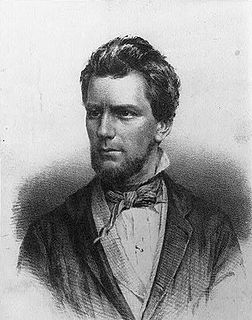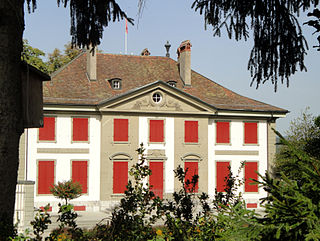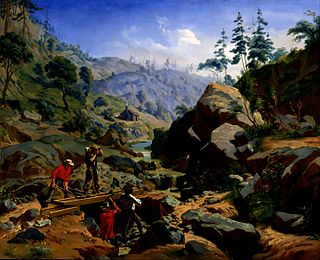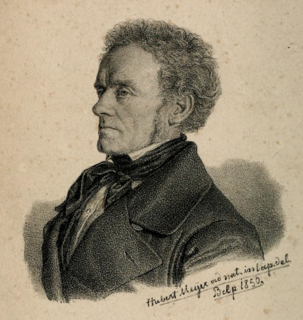
Bern or Berne is the de facto capital of Switzerland, referred to as the "federal city". With a population of about 133,000, Bern is the fifth-most populous city in Switzerland, behind Zurich, Geneva, Basel and Lausanne. The Bern agglomeration, which includes 36 municipalities, had a population of 406,900 in 2014. The metropolitan area had a population of 660,000 in 2000.

Daguerreotype was the first publicly available photographic process; it was widely used during the 1840s and 1850s. "Daguerreotype" also refers to an image created through this process.
Events from the year 1787 in art.

Franz Xaver Winterhalter was a German painter and lithographer, known for his flattering portraits of royalty and upper-class society in the mid-19th century. His name has become associated with fashionable court portraiture. Among his best known works are Empress Eugénie Surrounded by her Ladies in Waiting (1855) and the portraits he made of Empress Elisabeth of Austria (1865).

The Federal Palace is a building in Bern housing the Swiss Federal Assembly (legislature) and the Federal Council (executive). It is the seat of the government of Switzerland and parliament of the country. The building is a listed symmetrical building complex just over 300 metres (980 ft) long. It is considered one of the most important historic buildings in the country and listed in the Swiss Inventory of Cultural Assets of National Importance. It consists of three interconnected buildings in the southwest of Bern's old city. The two chambers of the Federal Assembly, the National Council and Council of States, meet in the parliament building on Bundesplatz.

John Adams Whipple was an American inventor and early photographer. He was the first in the United States to manufacture the chemicals used for daguerreotypes. He pioneered astronomical and night photography. He was a prize-winner for his extraordinary early photographs of the moon and he was the first to produce images of stars other than the sun. Among those was the star Vega and the Mizar-Alcor stellar sextuple system, which was thought to be a double star until 2009.

The Lohn Estate is a manor and estate located in Kehrsatz, canton of Bern, Switzerland. It serves as the official estate of the Swiss Federal Council. From 1942 to 1994, the Lohn Estate accommodated the official guests of the Swiss Confederation, which have included a number of heads of States and royalty. It is a Swiss heritage site of national significance.
Carl Ahasver von Sinner was a Bernese architect of the Louis XVI period.
Events from the year 1796 in art.

Johann Baptist Isenring was a Swiss landscape painter and printer. He was also the first Daguerrotypist in Switzerland.

Joseph-Philibert Girault de Prangey was a French photographer and draughtsman who was active in the Middle East. His daguerreotypes are the earliest surviving photographs of Greece, Palestine, Egypt, Syria and Turkey. Remarkably, his photographs were only discovered in the 1920s in a storeroom of his estate and then only became known eighty years later.

John Jabez Edwin Paisley Mayall was an English photographer who in 1860 took the first carte-de-visite photographs of Queen Victoria. He is most well known for his 1875 portrait of Karl Marx.
Events from the year 1775 in art.
Carl Nebel was a German engineer, architect and draughtsman, best known for his detailed paintings and lithographic prints made from them of the Mexican landscape and people during the battles of the Mexican–American War.

John Henry Bufford (1810-1870) was a lithographer in 19th-century Boston, Massachusetts.
Arthur Nahl was a German-born artist, daguerreotyper, engraver, portraitist, and landscape painter. Nahl was a painter known for his American Old West paintings of California. He was considered one of California's finest engravers, and was ranked amongst the best gymnasts in California for his time.

Frederick August Wenderoth or F. A. Wenderoth was a German-born American painter and photographer. Born and educated in Cassel, where he first learned to paint from his father, he established a lifelong friendship with Charles Christian Nahl at school. During the 1840s period of political upheaval in Hesse, he moved to Paris, where he was joined by Nahl and his half-brother Arthur Nahl.

Hermann Krone was a photographer from Saxony, Germany, who was born in Breslau. His father was a lithographer and he began an apprenticeship with him 1843. He produced his first calotype and daguerreotype photographs in 1843. He opened a studio in Leipzig in 1851 and in Dresden from 1852. He took landscape photographs of Saxon Switzerland. He married Clementine Blochmann and had four children including Sigismund Ernst Richard Krone.

Louise Franziska Möllinger (1817–1880) was a pioneering German-born Swiss photographer who worked with daguerreotypes in the early 1840s. She is thought to be the first female photographer who was active in Switzerland. Möllinger was also the first in Switzerland to use lithography as a means of publishing multiple copies of her landscapes as early as 1844.

Ludwig Emanuel Schaerer was a Swiss pastor and lichenologist. Interested in natural history from a young age, Schaerer trained as a teacher and studied theology in Bern. During his career as a teacher, orphanage director, and pastor, he researched extensively and maintained correspondence with foreign botanists interested in cryptogams. Schaerer was best known for his multi-volume work Lichenum Helveticorum Spicilegium, published in 12 parts from 1823 to 1842. This series catalogued and described the lichens of Switzerland, particularly those in the Alps, where he often went on collecting excursions. In another series, he compiled and distributed dried herbarium specimens acquired from his collections. Several lichen taxa have been named in honour of Schaerer.


















